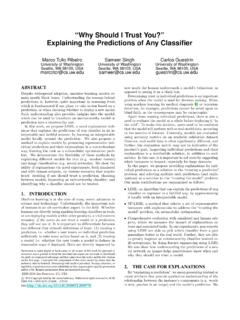Transcription of Decision Support System - Tutorialspoint
1 - Decision Support SYSTEMMIS - Decision Support SYSTEMD ecision Support systems DSS are interactive software-based systems intended to help managersin Decision -making by accessing large volumes of information generated from various relatedinformation systems involved in organizational business processes, such as office automationsystem, transaction processing System , uses the summary information, exceptions, patterns, and trends using the analytical Decision Support System helps in Decision -making but does not necessarily give a Decision Decision makers compile useful information from raw data, documents, personal knowledge,and/or business models to identify and solve problems and make and Non-programmed DecisionsThere are two types of decisions - programmed and non-programmed decisions are basically automated processes, general routine work, where:These decisions have been taken several decisions follow some guidelines or example, selecting a reorder level for inventories, is a programmed decisions occur in unusual and non-addressed situations, so:It would be a new will not be any rules to decisions are made based on the available decisions are based on the manger's discretion, instinct, perception and example, investing in a new technology is a non-programmed Support systems generally involve non-programmed decisions.
2 Therefore, there will beno exact report, content, or format for these systems. Reports are generated on the of a DSSA daptability and flexibilityHigh level of InteractivityEase of useEfficiency and effectivenessComplete control by Decision -makersEase of developmentExtendibilitySupport for modeling and analysisSupport for data accessStandalone, integrated, and Web-basedCharacteristics of a DSSS upport for Decision -makers in semi-structured and unstructured for managers at various managerial levels, ranging from top executive to for individuals and groups. Less structured problems often requires the involvementof several individuals from different departments and organization for interdependent or sequential for intelligence, design, choice, and for variety of Decision processes and are adaptive over of DSSI mproves efficiency and speed of Decision -making the control, competitiveness and capability of futuristic Decision -making of interpersonal learning or it is mostly used in non-programmed decisions, it reveals new approaches and sets upnew evidences for an unusual automate managerial of a DSSF ollowing are the components of the Decision Support System :Database Management System DBMS.
3 To solve a problem the necessary data may comefrom internal or external database. In an organization, internal data are generated by asystem such as TPS and MIS. External data come from a variety of sources such asnewspapers, online data services, databases financial,marketing, Management System : It stores and accesses models that managers use to makedecisions. Such models are used for designing manufacturing facility, analyzing the financialhealth of an organization, forecasting demand of a product or service, Tools: Support tools like online help; pulls down menus, user interfaces, graphicalanalysis, error correction mechanism, facilitates the user interactions with the of DSST here are several ways to classify DSS.
4 Hoi Apple and Whinstone classifies DSS as follows:Text Oriented DSS: It contains textually represented information that could have a bearingon Decision . It allows documents to be electronically created, revised and viewed as Oriented DSS: Database plays a major role here; it contains organized andhighly structured Oriented DSS: It contains information in spread sheets that allows create,view, modify procedural knowledge and also instructs the System to execute self-containedinstructions. The most popular tool is Excel and Lotus Oriented DSS: It is based on a solver, which is an algorithm or procedure written forperforming certain calculations and particular program Oriented DSS: It follows certain procedures adopted as Oriented DSS: Procedures are adopted in rules oriented DSS.
5 Export System is DSS: It is built by using two or more of the five structures explained of DSSF ollowing are some typical DSSs:Status Inquiry System : It helps in taking operational, management level, or middle levelmanagement decisions, for example daily schedules of jobs to machines or machines Analysis System : It needs comparative analysis and makes use of formula or analgorithm, for example cash flow analysis, inventory analysis Analysis System : In this System data is analyzed and the information report isgenerated. For example, sales analysis, accounts receivable systems, market analysis System : It keeps track of accounting and finance related information, forexample, final account, accounts receivables, accounts payables, etc.
6 That keep track of themajor aspects of the Based System : Simulation models or optimization models used for Decision -makingare used infrequently and creates general guidelines for operation or [MathJax]/jax/output/HTML.
















